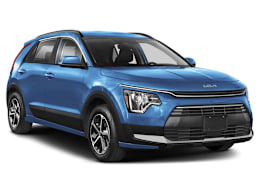The redesigned Kia Niro plug-in hybrid electric vehicle (PHEV) benefits from the improvements we found in the also-new Niro Hybrid, such as sharper handling, yet it’s quicker and more fuel-efficient than its hybrid sibling. As with the previous-generation, the Niro’s interior size and functionality rival that of a small SUV. Its biggest downside may simply be that it isn’t available with all-wheel drive, unlike most SUVs.
According to the EPA, the Niro PHEV has an estimated all-electric range of 33 miles, after which it transitions to hybrid (gas and electric) operation. In that mode it returned 47 mpg in our testing, which is a 2-mpg improvement over the regular Niro Hybrid. This is a rare achievement; since PHEVs usually weigh more than their regular hybrid counterparts (the Niro PHEV carries an extra 265 pounds over the regular hybrid version), they typically get worse fuel mileage when operating in gas-electric hybrid mode without the benefit of a charged battery.
For consumers new to PHEVs, these are hybrids with larger batteries that can be plugged into a standard 120-volt outlet, or a 240-volt EV charger. This gives the vehicle a dedicated electric-only driving range (typically for about 20 to 40 miles, depending on the model) for commuting and running errands, which is something that regular hybrids can’t do. When the battery is drained, the vehicle switches to regular hybrid operation. This also means that, unlike a full battery-electric vehicle, there is no need to find a public charger on a long trip because the gas engine takes over once the electric range is used up.
For buyers who are nervous about going all-in for an EV, a plug-in hybrid could be a logical and cautious step toward electrification. PHEVs make especially good sense if you have a short commute to work, rarely drive long distances, and have the ability to plug in your vehicle at home to charge overnight—it’s bound to save you lots of money at the gas pump. Plus, unlike regular hybrids, a PHEV may be eligible for federal tax credits. Considering that the average American drives less than 40 miles per day, this means many people will be able to do most of their daily commute on electric power while reserving the gas engine for longer trips.
The Niro PHEV drives similar to an EV when it’s using electric power. Once the hybrid battery drops to about 15 percent and those initial silent miles are over, the car transitions to regular hybrid operation, at which point it switches back and forth between electric power and the 1.6-liter four-cylinder gasoline engine. The driver can, however, choose to save the “electric miles” for later use, rather than the default up-front choice. For example, you may want to do this if you know there will be miles of city driving following a highway cruise. It’s more efficient to use electric power at low speeds rather than on the highway. With its electric miles and impressive fuel economy, the Niro PHEV has a total range of about 500 miles.
Thanks to a total system output of 180 horsepower, we clocked the Niro PHEV at 7.4 seconds in our 0 to 60 mph acceleration test. That’s considerably quicker than the Niro Hybrid (8.9 seconds), but a bit behind the Niro EV (7.1 seconds). Regardless of the mode, the powertrain seamlessly blends electric and gas power, and we prefer the Niro's six-speed dual-clutch automatic transmission over some of the continuously variable transmissions (CVTs) found in other hybrids and PHEVs, because it delivers a more natural feel thanks to its smooth, conventional shifts.
It takes 5.5 hours to charge the 11.1-kilowatt-hour battery on a regular 120-volt household current with the supplied mobile charging cable, and three hours to charge using a 240-volt (Level 2) connection. This means that owners can get away with using regular household voltage to charge the Niro PHEV rather than incurring the cost to install a dedicated higher-voltage wall charger like you would want to do if you owned a full EV.
Many other aspects of the PHEV are similar to the Niro Hybrid. That includes the slightly disconnected, rubbery feel of the steering, although the small hatchback turns into corners responsively enough. Body roll becomes noticeable when you take a turn with some verve, which endows the car with more of a mundane—rather than sporty—feel. Still, the Niro PHEV showed impressive agility and secure handling through our avoidance maneuver test, aided by its modest size and weight.
One area where the PHEV trails its siblings is in braking performance. Overall, it has longer stopping distances than the other Niro variants, particularly in the wet. At least the brake pedal feels mostly normal, which isn’t always the case with PHEVs, hybrids, or EVs, though it can be a bit grabby at times. The pedal also feels somewhat soft and spongy during the transition between regenerative braking (which slows the car when you’re coasting, while recouping energy back to the battery) and the brake pads actually grabbing the rotor.
The Niro PHEV slots in between the other Niros when it comes to ride quality. It’s better than the hybrid, with improved compliance over bumps, some of which is likely due to the PHEV’s added weight. On rare occasions, such as larger potholes or repeated sharp bumps over broken pavement, the suspension will be overwhelmed and transmit the impacts into the cabin.
No matter whether the Niro PHEV is operating under electric- or gas power, the car is never particularly quiet. Road and tire noise are pronounced, and particularly evident when driving in electric mode due to the lack of internal combustion engine sounds. Wind noise is also elevated, and there is a noticeable resonance coming from the rear-seat area. Unlike the hybrid version, the gas engine is mostly quiet and refined, and any noise it generates is drowned out by the road, tire, and wind noise that permeates the cabin.
For the most part we found the front seats comfortable; they offer a nice pocket to sit in, with adequate levels of lateral support to hold you in place through corners. But many drivers found they needed to adjust the steering wheel into an uncomfortably high position in order for the rim to not block the upper part of the rectangular instrument panel. The rear seat has a rather flat shape, but it has tons of headroom and plenty of foot space underneath the front seats; taller passengers might find themselves short on knee room, though.
The Niro’s upright stature strikes a nice balance between low-slung sedans and taller-riding small SUVs, which makes it easy to get in and out of. We also appreciate the airy forward visibility, which gives a good view of the road ahead. Unfortunately, the new “Aero Blade” rear roof pillars, in place of a third side window, make for huge blind spots back there. Kia says this design element allows air to slip between the pillar and the Niro’s body near the liftgate, aiding aerodynamics and, therefore, efficiency. Practicality is helped by the Niro’s hatchback design, which generously allowed us to fit four large suitcases behind the rear seats, and there’s a competitive 25 cubic-feet of cargo space with the rear seats folded down.
Many of the Niro’s controls are straightforward and easy to use. But like the Niro Hybrid and EV, the split-use climate/media touchscreen-panel below the infotainment display is frustrating to use while driving. It requires toggling back and forth between the climate and media systems, which is annoying.
Kia markets its active safety and driver assistance features under the “Kia Drive Wise'' banner. Both of the Niro PHEV trims come standard with automatic emergency braking with pedestrian and cyclist detection, automatic emergency braking that operates at highway speeds, blind spot warning, rear cross traffic warning, reverse automatic emergency braking, lane centering assistance, lane departure warning, lane keeping assistance, adaptive cruise control, and automatic high beams.


























